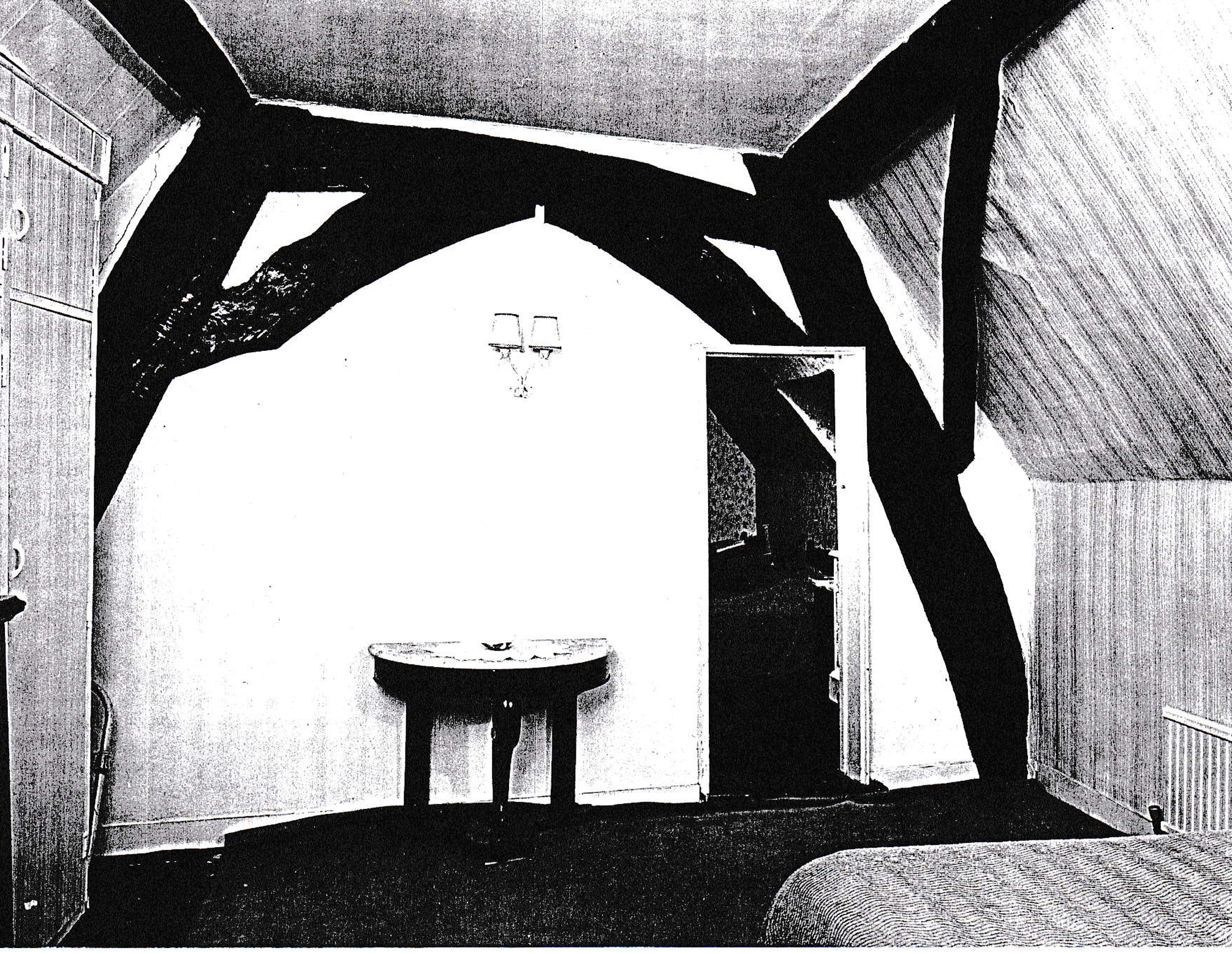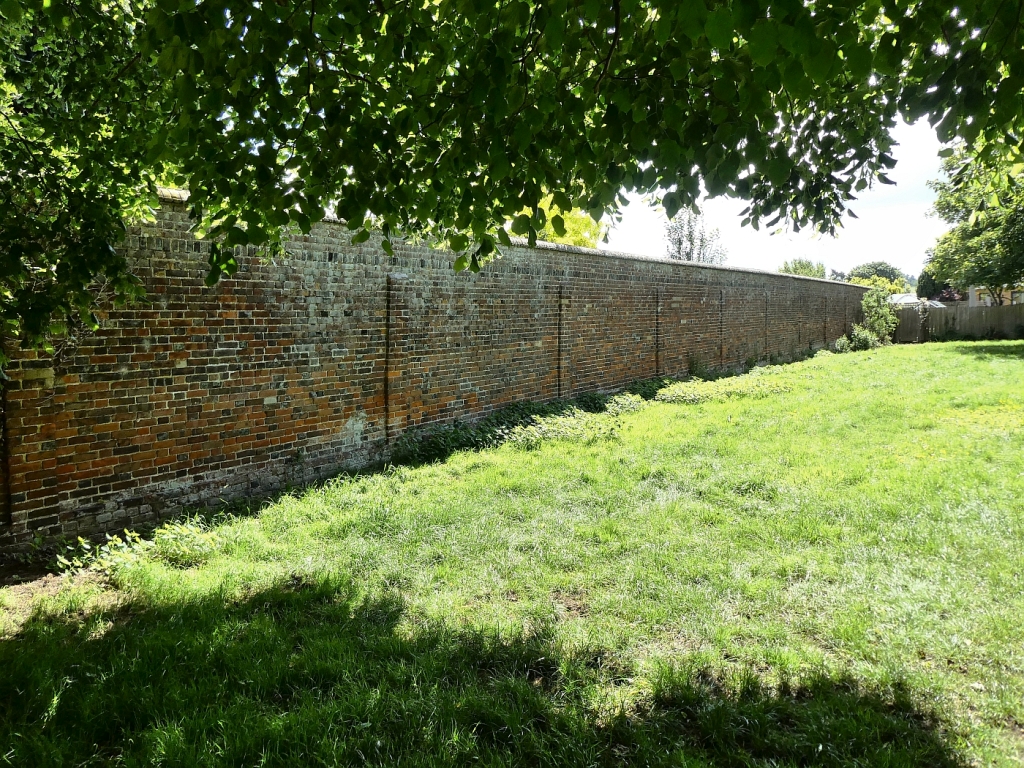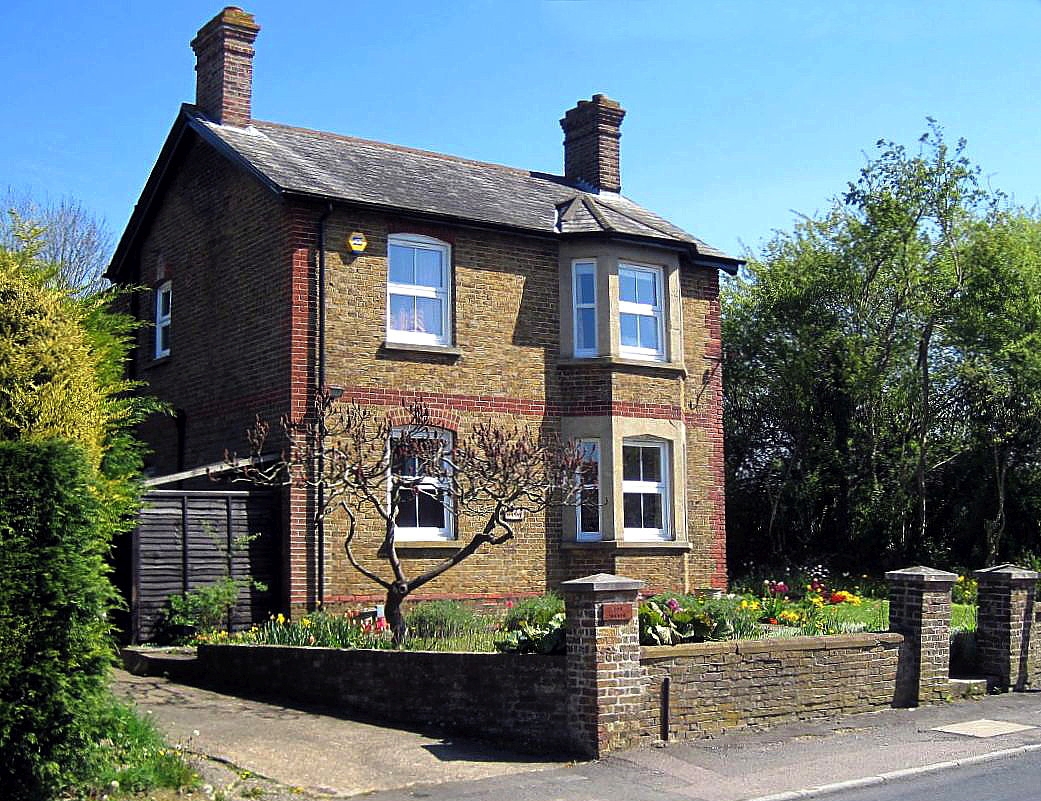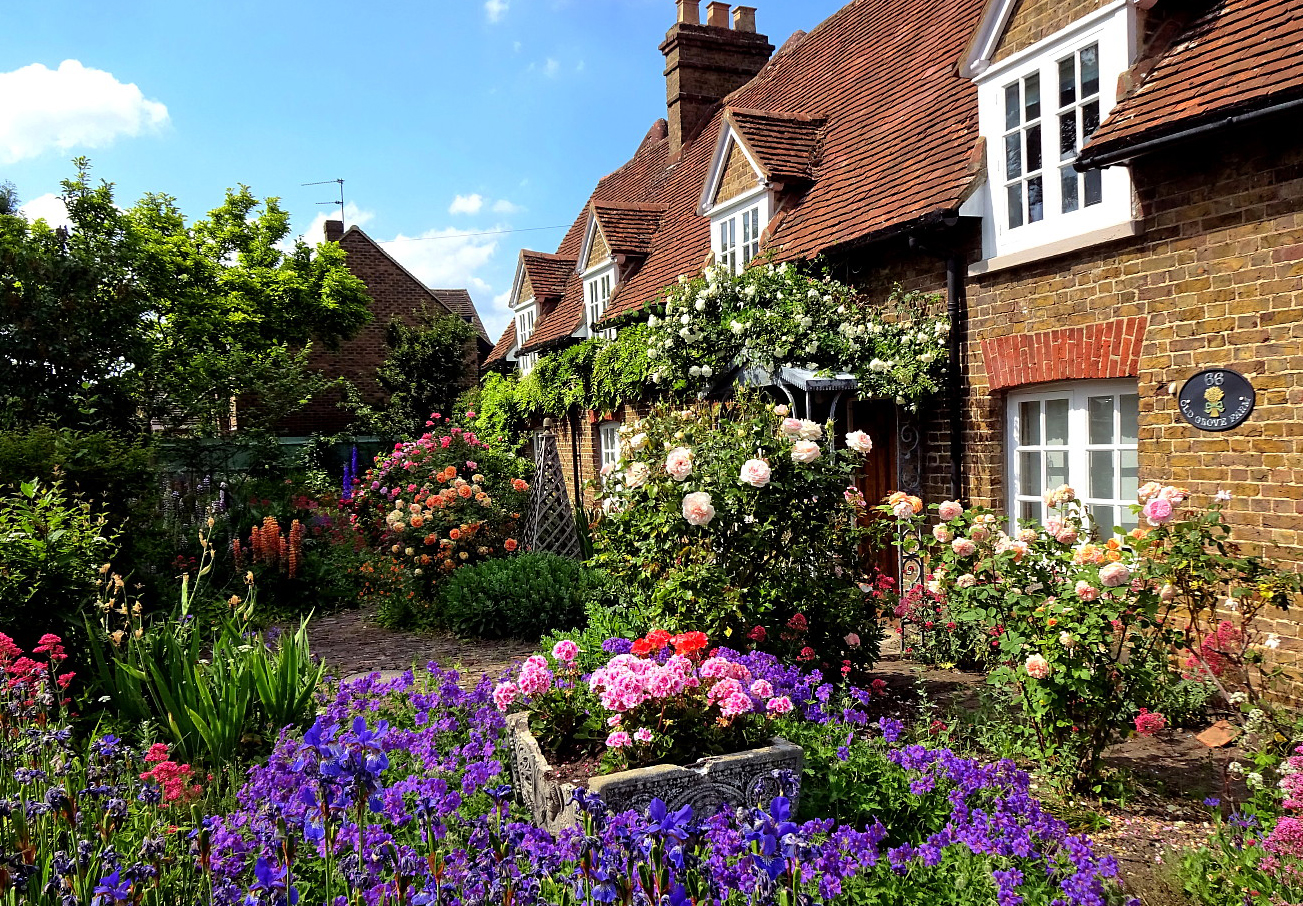|
Grove Farm
Cottages (now Old Grove Farm), shown c. early-1970s
In the Listings [3], it is described as being a late medieval cruck-framed house, aligned N-S with formerly an open hall,
timber frame, brick nogged and roughcast, the front in yellow
stock bricks and the rear wing encased in red brick.

Interior
of Old Grove Farm showing a cruck frame.
This building served as the farmhouse for Tring Grove Farm up to
about the end of the 19th century when a new and larger
farmhouse was erected on the north side of Marshcroft Lane. In
the 1920s it is known that it was occupied by the Halstead
family until they emigrated to Canada in 1931. During the
following years, this property was modernised and tenanted by
farm workers, and was later sold as a private house to a Mr
Rutland, followed by a Mr Figg when further alterations were
made [4]. The present owners have carried out
further modernisation
and created a beautiful garden fronting Grove Road, giving
pleasure to passers-by during the summer months.
FOOTNOTES
1. Archaeolgia, vol.iii, 1775.
2. Grove has a very tenuous connection with the American
Washington family. John Dagnall was married to a sister of
Amphyllis Washington, who lived in Tring in what is now Frogmore
Street, and was the great-great-grandmother of the famous George
Washington.
3. Planning (Listed Buildings and Conservation) Act 1990.
4. Information from two Halstead daughters who visited in 1984.
――――♦――――
THE
EIGHTEENTH CENTURY
The
Seare Family
The history of Tring Grove becomes a little clearer in the 18th
century when the estate was acquired by the Seare family,
originally esquires to French knights who came to England in the
15th century. Having settled and then acquired the nearby Manor
of Marsworth De-la-Hay, they remained for over 250 years [1].
It is likely they purchased the Tring Grove estate from owners,
the Dagnalls, who had lived at Grove for several generations,
and to whom they were related by marriage. At some stage a new
mansion house was erected, which in due course descended to John
Seare. References to this property include a payment in 1764 to
Nathaniel Richmond, a noted nurseryman of the time, for £31, a
considerable sum [2]. And in 1767 we are told John Seare was
exempt from his statutory duty of contributing to road repairs,
providing “he maintains the New Road (presumably Grove Road) at
his own expense” [3]. Three years later it is recorded in Tring
Vestry Minutes that John Seare, together with other leading
citizens, subscribed towards the town’s first ever fire engine,
stating it to be “a thing of Public Utility and very necessary”.
In 1785 the two farms at Grove were advertised to let but at
that time the acreage was considerably less than later on.

Map
(extract) drawn by Andrews and Drury, 1766.
John Seare had married Mary Stevens in 1758, and died at his
house in Grove in 1792 after a lingering illness. A year later
Mary had dealings with the Grand Junction Canal Company during
the construction of this new waterway. In the GJC Act of 1793
a
clause records that:
“Pleasure Grounds not be taken, but whereas Mary Seare,
widow, owns a certain plantation or pleasure ground with a piece
of water thereon, called Bulbourne Head [4] in the parish of
Tring, and consents to canal being made through same, canal to
be carried through the said water on the west wide of the east
arm thereof, first making a bank or dam between canal and south
east arm, such bank to be same height as present banks of arm,
so as to keep water in arm the same height. Sluice to be put in
south bank so that Mrs Seare can let down water from south arm
to level of canal if desired. No lock to be made within one mile
either side of Bulbourne Head without owner’s consent.”
John Seare had left his lands in the Parishes of Marsworth,
Tring and Puttenham to his wife, desiring that she should leave
part of his estate to his nieces, one of whom was married to
Edward Barker (see below). Mary died in 1798 and in turn
bequeathed her estates to Henrietta her unmarried daughter who,
despite her name appearing on old maps as ‘Mrs’, (this was a
courtesy title in the 18/19th centuries accorded to women owning
property or land) and her brother. Upon Henrietta’s death in
1807, the Seare name ceased, and from then on matters became
very convoluted with cases in the Court of Chancery ensuing [5].
Eventually Grove House itself was devised to Edward Barker whose
daughter had married into the Lake family of Aston Clinton [6],
thus establishing a connection between the Seares and Lakes. Sometime Consul at Tripoli, Edward Barker’s own estate was in
Sussex and, accordingly, he let the house to the brother of Lady
Dashwood of Halton.

Map drawn
by Charles Smith, 1808.
(Modern spelling: Mefwell = Miswell: Donlee = Dunsley)
It seems that Mary Seare’s house at Grove was a rather grand
establishment (at the time of the Inclosure Act of 1797 it was
valued at £25, a considerable amount) as immediately after her
death, all the furniture and effects were advertised for auction
in local papers. Every item was carefully listed, from bedsteads
with Indian damask hangings to dinner table napkins and wine. Outside, all the livestock was sold too, including two black
geldings (“remarkable quiet”), cows, heifers, pigs, hens, ducks,
and “two beautiful peacocks”. Also, a carriage (“the linings,
wheels and every part in perfect good condition, nearly equal to
new, with plated harness compleat”), carts, an “Irish car”, all
farm and garden equipment, tools, summer seats (“made to turn
upon spindles”), as well as a “pleasure boat” and fishing nets,
used on Bulbourne Head [see map above, top right], in those days a sizable
stretch of water lying within the boundary of the estate. The
advertisement ended by stating “The Grove-house and Farm to be lett and may be entered on immediately”.
Although not residing in Tring, Edward Barker appeared to be
conscious of his civic duty as:
“With truly philanthropic and beneficent, having subscription
amongst themselves, and which has been promoted by Sir Smith,
Bart, Edward Barker, Esq., John Lee, Esq. and other proprietors
of estates in Tring Parish amounting to the sum of £120, which
has been laid out in purchase of beef of the best quality, and
distributed to the poor and necessitous inhabitants of the town
and its vicinity.” [7]
Edward Barker died in 1835 and, according to a notice (written
by his family), “a most amiable and charitable man lamented by
his family, his tenants and the poor”.
Robert Hill (‘The Learned Tailor’)
A notable resident of Grove at this time, albeit for a short
while and from the other end of the social scale, was a
self-educated farm boy who acquired some distinction by becoming
a linguist and man of letters. Born in 1699 at Miswell, then a
hamlet of Tring, when his father died his mother married a
tailor and moved to Buckingham, leaving Robert in the care of
his grandmother who taught him to read, and arranged some brief
schooling. In 1710 the pair moved to Tring Grove where Robert
became a farm boy. However, his constitution proved too delicate
for this work and he joined his mother in Buckingham where he
was apprenticed as a tailor and stay-maker.
Here, he was given two books – a grammar and three-quarters of a
dictionary. These fired his imagination and created an obsessive
desire to read and, as his master allowed him no leisure, he
procured candles to study at night. A few years later Buckingham
was hit by an outbreak of smallpox and Robert returned to Tring
Grove to tend sheep, where he is said to have sat all day under
a hedge reading his limited library. That was his last
connection with Grove, as he returned to Buckingham, was married
and widowed twice, became a schoolmaster, married again
(unsatisfactorily), travelled the country as an itinerant mender
of clothes and stays, and studied mathematics, Latin, French,
Greek and Hebrew.

A book title
by Joseph Spence, comparing
Robert Hill with a noted Florentine scholar.
A clergyman named Joseph Spence became so impressed with Robert
that he gave him employment and encouraged him to write his own
works. A steady stream of literary output followed, all entirely
unreadable today; as an example one title will suffice –
Christianity the True Religion, an Essay in answer to the
Blasphemy of the Deist. Always in financial difficulties, his
last years were sad culminating in a long final illness, but the
extraordinary mental ability of this Tring farmer’s boy helped
him to achieve general recognition. [8].
FOOTNOTES
1. Magna
Brittania, 1806.
2. The Parks and Gardens of West Hertfordshire by Tom
Williamson (pub.2000).
3. Tring Vestry Minutes, 1767.
4. from Topography of Great Britain by George Alexander
Cooke, pub. 1817 - “about two miles from Ivinghoe is a place
called Bulbourne, belonging to John Seare, Esq. of Tring Grove. Here is said to be the original source of the River Thames there
are two springs, which divide within ten yards of each other ……
Mr Seare has made a fine canal for a pleasure boat one mile in
length.”
5. Reports of Cases in Chancery, vol. xvii, pub.1845
6. The Complete Peerage, Vol.5
7. Northampton Mercury, 16 January 1813
8. National Dictionary of Biography (Tring Parish Magazine,
October 1906)
――――♦――――
THE NINETEENTH CENTURY
Grove House
It seems little maintenance had been carried out on Grove House,
for in 1811 a surveyor from Luton, commissioned by Edward Barker,
issued a damning report describing the ‘mansion’ as being very
dilapidated and not lettable. He [1] recommended it should be
pulled down and the materials sold. (One account says that they were
later used to build Surrey Place, a courtyard of workers’
cottages in Akeman Street, Tring.) When Grove House was eventually
demolished is not recorded, and the facts are confusing, but it
could be inferred that this happened before a mapping survey
carried out in 1820 when the house is not shown; nor does it
appear
on any maps after that date. A replacement for Grove House was
built on a site more to the east (i.e. nearer to Grove Road), but exactly when this occurred
is again uncertain, for in 1812 a house was being advertised as -
“Mansion House, Tring Grove, to let for 12 years”, so it is
difficult to say to which house the advertisement refers.
In the early 1840s the estate agent William Brown advertised a prestigious residence at Tring Grove Park, describing it as
“situated between town and railway station, and affording a
desirable summer retreat, being encircled by a pleasant park. It
also boasts a chaise house, stabling, a large walled garden, and
a small quantity of meadow if desired.”
Grove Place
This property appears to have been roughly on the site of the
old Pendley laundry and, as mentioned previously, on the OS map of
1922 it is no longer shown.
In February 1813, a sad little notice appeared in The Northampton
Mercury announcing the death “at Grove Place, the only
child of T. Kingham, gent. of Tring town”. Thomas Kingham was
an affluent farmer, property and land owner, his apparently
substantial house being valued at the time of the Inclosure Act of
1797 at £24.17s.0d. (only 3s. less than the value of Grove
House). He lived there until his death in 1832, when an
auction sale of his estates around Tring was held at the Rose &
Crown, and his holdings in Marshcroft Lane alone included a farm
homestead, cottages and 10 acres of rich pasture. After the
auction, The Bucks Gazette reported that “the freehold
and copyhold estates of Mr. Kingham of Tring Grove realised much
higher prices than property was ever known to have been sold for
by public auction in that neighbourhood, every lot being
disposed of.”
Acquisition of Grove estate by Viscount Lake
After the death of Mary Seare’s immediate heirs, the entire
Tring Grove estate, apart from the mansion house, had been
acquired by Viscount Lake of Aston Clinton [2]. The two farms on
the estate were leased to tenants, John Soames followed by
Thomas Woodman at Grove Park Farm and Ebenezer Southernwood at
Tring Grove Farm. It seems that all were successful, as local
papers of the time are full of accounts of their prizes won at
agricultural shows.
.jpg)
Viscount
Lake.
Also, Thomas Woodman allowed Tring Cricket Club regular use of
the park for practice and matches (roughly in the area where
Chiltern Way is situated) [3]. Local papers of the 1830s give
accounts of cricket played at Grove, one example from July 1834
gives a flavour of the
times:
“GRAND CRICKET MATCH – A game of this favourite and manly old
English amusement was played at Tring Grove between four
amateurs. On the one side was a gentleman from Tring Grove and
another from Chesham, on the other there were two gentlemen from
Berkhamsted. Each party was allowed the assistance of a scout. The game was played with great spirit, and came off with
infinite éclat for Tring Grove and Chesham. When the game was
thrown up, the parties retired to Grove House where an excellent
collation had been provided by the hospitality of the worthy
host, and good fellowship and hilarity were the order of the
day.”
In later years football matches were also played; newspaper
reports of the 1890s record that the Brigade Ground of the
Church Lads’ Brigade was sited on Tring Grove and used for
matches against visiting teams. The park was also lent for
occasions more spiritually uplifting than sport, one example
from 1860 is the gala of Tring Temperance Society with the
Excelsior Band of Hope in attendance.
Apart from the farmers, the residents of Tring Grove and
Marshcroft Lane properties appear like the majority of
inhabitants of Tring to be modest folk. In the Census of 1851 we
learn that there were 23 houses, almost all the occupants
working as agricultural labourers, straw plaiters, or on Parish
relief. The few exceptions are listed as canvas weaver, game
keeper, under-gamekeeper, and huntsman; one poor soul is
recorded as “kept by children”.
Changing Times

Beech Grove in Station Road,
home of William Brown
shown shortly before demolition.
The real upheaval for this little community began in 1853 when,
following family disputes, the Court of Chancery ordered the
Lake family’s estate to be auctioned, the sale again arranged by
the ubiquitous William Brown (who at this date was living very
close by in a newly-built house in Station Road). Farms and
cottages went under the hammer; Grove Park Farm then
comprising 108 acres. This holding consisted of a farmhouse,
domestic offices, stabling for four horses, chaise-house,
granary and two tenements. Tring Grove Farm was larger at 296
acres, which included land at Bulbourne with a dwelling (used as
a beer-house), stabling, a yard and wharf.

Extract
from William Brown's Advertisement.
Pendley Manor property
The neighbouring Manor of Pendley had been purchased by the Rev.
James Williams in 1864[4], a member of a Norfolk family who had
made a fortune in the silk trade. At that time he was renting
and residing at Tring Park mansion prior to its acquisition by
the Rothschilds in 1872. A small part of the copyhold of the
Manor of Pendley included an area on the south side of Tring
Grove. A little later, once the Williams family were living in
their newly-constructed house at Pendley, some attractive pairs
of estate houses with decorative windows, porches, and tile
hanging, as well as a laundry building [5] to serve this big
house, were erected on this copyhold land in Marshcroft Lane.

Marshcroft
Lane cottages, c.1930.
In 1876 at a Tring Agricultural Association event, J.G.Williams
of the Pendley estate, permitted a ploughing competition to be
held on the land he owned, a site called Greenfield on the
approach to Park Hill Farm. We learn from the local paper that
the 11 competing teams started at nine o’clock and the first
prize would be awarded to the man “who shall plough in the
best manner, with two horses abreast, half-an-acre in four hours.”
Halfway down the lane at Marshcroft itself, two houses had been
erected by the Rothschild Estate in 1881 on the site of earlier
cottages (on the front of these properties square frames of
brickwork still outline the position of the original plaques
which bore the Rothschild coat-of-arms.) The occupants comprised
a farm carter, his wife and five children, and next-door lived a
shepherd, wife and four children. In 1890 these properties and
Park Hill Farm were the subject of a land exchange [6] between
Lord Rothschild and J G Williams, and at a later stage they were
bequeathed to Dorian Williams by his aunt. |













.jpg)





.jpg)















